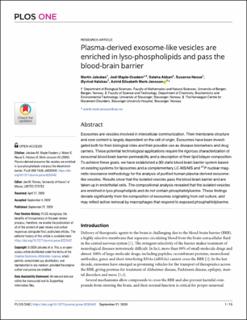| dc.contributor.author | Jakubec, Martin | |
| dc.contributor.author | Maple-Grødem, Jodi | |
| dc.contributor.author | Akbari, Saleha | |
| dc.contributor.author | Nesse, Susanne | |
| dc.contributor.author | Halskau, Øyvind | |
| dc.contributor.author | Mork-Jansson, Astrid Elisabeth | |
| dc.date.accessioned | 2021-05-07T13:21:19Z | |
| dc.date.available | 2021-05-07T13:21:19Z | |
| dc.date.created | 2020-09-30T20:24:17Z | |
| dc.date.issued | 2020 | |
| dc.Published | PLOS ONE. 2020, 15:e0232442 (9), 1-15. | |
| dc.identifier.issn | 1932-6203 | |
| dc.identifier.uri | https://hdl.handle.net/11250/2754220 | |
| dc.description.abstract | Exosomes are vesicles involved in intercellular communication. Their membrane structure and core content is largely dependent on the cell of origin. Exosomes have been investigated both for their biological roles and their possible use as disease biomarkers and drug carriers. These potential technological applications require the rigorous characterization of exosomal blood brain barrier permeability and a description of their lipid bilayer composition. To achieve these goals, we have established a 3D static blood brain barrier system based on existing systems for liposomes and a complementary LC-MS/MS and 31P nuclear magnetic resonance methodology for the analysis of purified human plasma-derived exosome-like vesicles. Results show that the isolated vesicles pass the blood brain barrier and are taken up in endothelial cells. The compositional analysis revealed that the isolated vesicles are enriched in lyso phospholipids and do not contain phosphatidylserine. These findings deviate significantly from the composition of exosomes originating from cell culture, and may reflect active removal by macrophages that respond to exposed phosphahtidylserine. | en_US |
| dc.language.iso | eng | en_US |
| dc.publisher | Public Library of Science | en_US |
| dc.rights | Navngivelse 4.0 Internasjonal | * |
| dc.rights.uri | http://creativecommons.org/licenses/by/4.0/deed.no | * |
| dc.title | Plasma-derived exosome-like vesicles are enriched in lyso-phospholipids and pass the blood-brain barrier | en_US |
| dc.type | Journal article | en_US |
| dc.type | Peer reviewed | en_US |
| dc.description.version | publishedVersion | en_US |
| dc.rights.holder | Copyright 2020 Jakubec et al. | en_US |
| dc.source.articlenumber | e0232442 | en_US |
| cristin.ispublished | true | |
| cristin.fulltext | original | |
| cristin.qualitycode | 1 | |
| dc.identifier.doi | 10.1371/journal.pone.0232442 | |
| dc.identifier.cristin | 1835861 | |
| dc.source.journal | PLOS ONE | en_US |
| dc.source.40 | 15:e0232442 | |
| dc.source.14 | 9 | |
| dc.identifier.citation | PLOS ONE. 2020, 15 (9), e0232442. | en_US |
| dc.source.volume | 15 | en_US |
| dc.source.issue | 9 | en_US |

